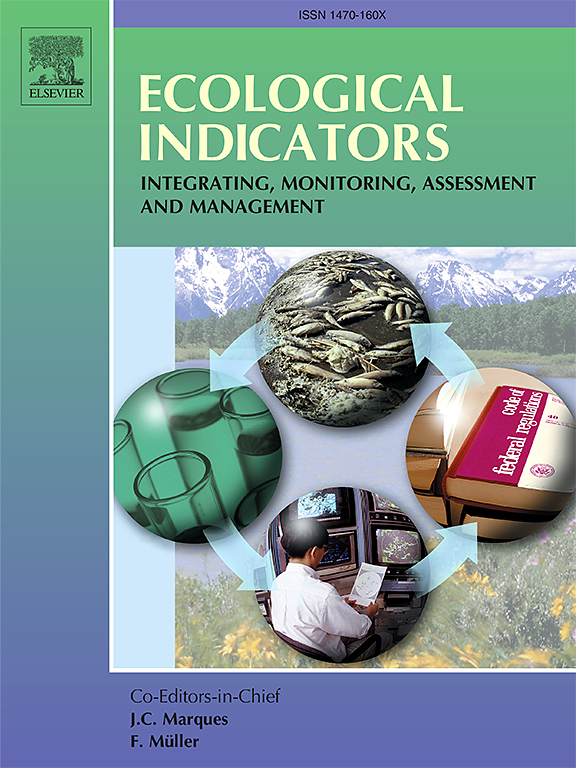城市保护规划的栖息地连通性建模——以美国俄亥俄州汉密尔顿县的冠啄木鸟为例
IF 7
2区 环境科学与生态学
Q1 ENVIRONMENTAL SCIENCES
引用次数: 0
摘要
城市森林提供了重要的野生动物栖息地,但随着城市化的加剧和树木资源的减少,这些栖息地变得越来越有限和分散。鉴于可供野生动物栖息地保护的资源有限,迫切需要价格合理、用户友好的工具和指标,以帮助确定栖息地保护工作的优先次序和优化,并使栖息地可达性与更广泛的保护目标保持一致。本研究的目的是提供一种方法来评估将小栖息地单元(垫脚石)作为美国俄亥俄州汉密尔顿县森林鸟类毛啄木鸟(Pileated Woodpecker, PIWO)整体栖息地可用性和可达性指标的重要性。为了提高我们方法的生态相关性,我们将PIWO的存在位置数据与详细的资源变量、土地利用和土地覆盖数据相结合。为了更好地解释生境质量和物种分布的异质性。为了获得当地社区对野生动物栖息地保护的更广泛支持,我们通过将景观图分析与土地征用决策相结合,考虑了保护项目的各种好处。该方法帮助我们确定了满足PIWO栖息地要求的大型栖息地斑块和小型栖息地单元,并评估了单个栖息地斑块/单元(包括现有的和新的)对整体栖息地可用性和连通性的贡献。我们确定的小垫脚石可以形成连接大型栖息地斑块的成本最低的走廊,从而提高物种对森林资源的可及性,并促进其在景观中的远距离传播。这表明了在PIWO保护中垫脚石和栖息地连通性的重要性。这些垫脚石的丧失将严重阻碍保护工作,而且难以弥补。我们发现,通过将当地规划目标纳入分析,可以很容易地识别出能够增强生态服务、改善栖息地连通性和可达性的潜在征地地点。这些结果有助于保护和重新造林的努力。本文章由计算机程序翻译,如有差异,请以英文原文为准。
Habitat connectivity modeling for urban conservation planning: A case study of pileated woodpecker (Dryocopus pileatus) in Hamilton County, Ohio, USA
Urban forests provide vital wildlife habitats, but as urbanization intensifies and tree resources dwindle, these habitats are becoming more limited and fragmented. Given the meager resources available for wildlife habitat conservation, there is a pressing need for affordable, user-friendly tools and indicators to help in the prioritization and optimization of habitat conservation efforts and in aligning habitat accessibility with broader conservation objectives. The aim of our study is to provide an approach to assess the importance of including small habitat unites (stepping stones) as an indicator of overall habitat availability and accessibility for a forest bird species, Dryocopus pileatus (Pileated Woodpecker, PIWO), in Hamilton County, Ohio, U.S.A. To improve ecological relevance in our approach, we integrated PIWO’s presence location data with detailed resource-based variables, as well as land use and land cover data, to better account for the heterogeneity in habitat quality and species distribution within land classes. To garner broader support from local communities for wildlife habitat conservation, we considered the diverse benefits of conservation projects by integrating landscape graph analyses with land acquisition decisions. This approach helped us identify large habitat patches and small habitat units that meet the PIWO’s habitat requirements and evaluate how individual habitat patches/units, both existing and new, contribute to overall habitat availability and connectivity. The small stepping stones we identified could form least-cost corridors that connect large habitat patches, thereby enhancing species’ accessibility to forest resources and promoting its long-distance dispersal across the landscape. This suggests the importance of stepping stones and habitat connectivity in PIWO conservation. The loss of these stepping stones would significantly hinder conservation efforts and be difficult to offset. We found that by incorporating local planning objectives in this analysis, potential land acquisition sites that can enhance ecological services and improve habitat connectivity and accessibility can be easily identified. These results are instrumental in preservation and reforestation efforts.
求助全文
通过发布文献求助,成功后即可免费获取论文全文。
去求助
来源期刊

Ecological Indicators
环境科学-环境科学
CiteScore
11.80
自引率
8.70%
发文量
1163
审稿时长
78 days
期刊介绍:
The ultimate aim of Ecological Indicators is to integrate the monitoring and assessment of ecological and environmental indicators with management practices. The journal provides a forum for the discussion of the applied scientific development and review of traditional indicator approaches as well as for theoretical, modelling and quantitative applications such as index development. Research into the following areas will be published.
• All aspects of ecological and environmental indicators and indices.
• New indicators, and new approaches and methods for indicator development, testing and use.
• Development and modelling of indices, e.g. application of indicator suites across multiple scales and resources.
• Analysis and research of resource, system- and scale-specific indicators.
• Methods for integration of social and other valuation metrics for the production of scientifically rigorous and politically-relevant assessments using indicator-based monitoring and assessment programs.
• How research indicators can be transformed into direct application for management purposes.
• Broader assessment objectives and methods, e.g. biodiversity, biological integrity, and sustainability, through the use of indicators.
• Resource-specific indicators such as landscape, agroecosystems, forests, wetlands, etc.
 求助内容:
求助内容: 应助结果提醒方式:
应助结果提醒方式:


